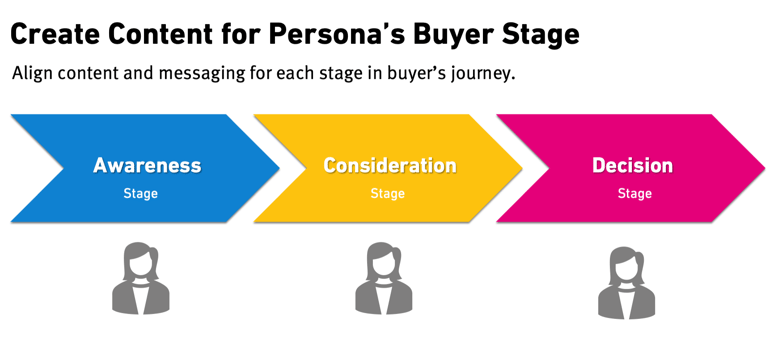If you’re in marketing, you’ve probably heard the term buyer personas used to describe a target audience. In the era of inbound marketing, buyer personas have become an essential element of any marketing strategy. Why? Because buyer personas help you understand your target customers better, allowing you to create a more personalized approach to messaging and content development.
Creating a buyer persona is a way to get into the head of your audience and understand their needs, goals and motivations. It can help you more effectively craft your marketing messages and create content tailored for each audience.
Inbound marketing is all about personalization: delivering the right message to the right person at the right time.
Let’s answer some important questions.
What is a buyer persona and why do you need one?
A buyer persona is a semi-fictional representation of a target customer. It is used in marketing to help you understand what motivates an individual’s behavior.
A buyer persona allows you to see the world through your target customer’s eyes so you can gain insight into what they find important and how they make decisions. This will help you create more relevant, compelling marketing campaigns tailored to your target audience.
What is the difference between a buyer person and a target audience?
Think of it like this: A target audience is an entire group you want to address while a persona is their elected representative.
A target audience is a segment of the "general public" or group of people with shared interests who you are addressing with your content or advertising, and whom you would like to obtain as customers. A persona is a semi-fictional portrait of an individual in this audience who stands in as a representative for the entire group.
The strongest buyer personas are based on market research as well as on insights you gather from your actual customer base (through surveys, interviews, etc.). Depending on your business, you could have as few as one or two personas, or as many as 10 or 20.
(Tip: If you’re new to personas, start small! You can always develop more personas later if needed.)
Need help creating buyer personas? Try a buyer-persona workshop.
Uncovering your audience’s pain points
One way to get to know your target persona is through audience research and market analysis. This involves finding out what problems your audience has and then using that knowledge in your marketing strategy.
For example, if you’re introducing a new lab instrument to a life science audience, you might find that one of the main problems they have is getting the results they obtain from the instrument seamlessly integrated into their workflow.
You could use this knowledge to create a campaign that focuses on automation and integration in your next campaign, which could be the type of message that resonates with them.
Steps to creating your buyer personas
A buyer persona is not just a demographic profile but rather a picture of a living, breathing human being with their own hopes, dreams, and frustrations. Tapping into these hopes, dreams and challenges is the key to creating effective marketing campaigns.
To create your buyer persona, start by listing the types of people who purchase your product. Once you've narrowed down who your customer is, think about what types of things they might be looking for. What are their interests? What are their primary pain points? Do they care more about price or quality? If you're a company that sells insurance, for example, you might want think about what life stages compel people to change (or buy) insurance, or what their financial situations look like.
To create buyer personas, follow these essential steps:
- Identify the key pain points of your customers. What are their goals and what challenges do they encounter in meeting these goals? What are they trying to solve in their work (or life)? What would make their job easier?
- Research and define your customer’s demographics. Some information you want to include: their job title, career path, education, sex, age, income, marital status/family, location (urban or rural), hobbies, charitable interests, etc.
- Create an in-depth profile of your target’s day-to-day life or work. For a B2B audience, this includes things such as: what does their day look like: are they in an office, working from home, commuting, in a lab, traveling all day? What are their career milestones? How much influence do peers have on their jobs? Are they the boss, or a subordinate? How are they measured in their work? How are purchasing decisions made?
- Align your strategy with your persona’s needs and goals. Determine how you can meet their needs or help them achieve their goals. What messages do they want to hear? What will they have objections about? How can you help make them a hero in their work?
How do you use personas?
At the most basic level, personas allow you to personalize or target your marketing for different segments of your audience. For example, instead of sending the same lead nurturing emails to everyone in your database, you can segment by buyer personas and tailor your messaging according to what you know about those different personas.
For instance, if one of your audiences is teachers, you might send that persona content that helps them interact more effectively with parents and students. For an administrator persona, you’d have a separate set of lead nurturing emails focused on efficiency or ROI.
When combined with the lifecycle stage (i.e. how far along someone is in your sales cycle), buyer personas also allow you to map out and create highly targeted content.
Seventy-one percent of consumers expect companies to deliver personalized interactions. And seventy-six percent get frustrated when this doesn’t happen.
Conclusion
Defining your target audience and creating precise personas helps you elevate your marketing strategy. It clarifies your understanding of your customers' needs and wants, as well as their motivations. Well-documented personas are indispensable for preparing content that delivers a personalized experience for the customer, which helps draw them to you. That's a win-win as you have the potential to help them.
If you need help in constructing your buyer personas or collecting input from your team to create effective buyer personas that can inform your marketing strategy, consider holding a team workshop.
Get started now: Download our free ebook on creating buyer personas, along with some useful templates


